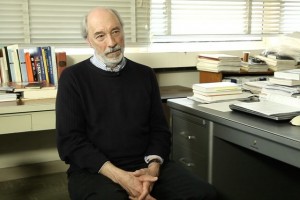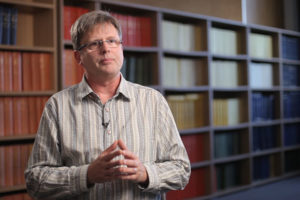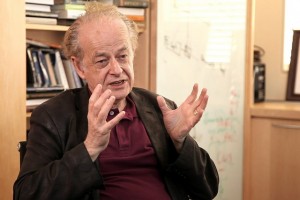Proton – Proton Collisions at High Energy
Physicist Frank Taylor on the Higgs boson, supersymmetry, and physics beyond the Standard Model

In November Advanced Materials published an article called “Amyloid Templated Gold Aerogels“. We asked one of the authors, Prof. Raffaele Mezzenga from Swiss Federal Institute of Technology in Zürich, to comment on this study.
We have designed ultra low-density aerogels made of milk protein nanofibrils, the so called amyloid fibrils, and, by functionalization with gold nanoparticles and nanocrystals, amyloid-templated gold aerogel hybrids of unprecedented lightness and functionality. By changing the gold nanoparticles shape, size and concentration, the gold composition can be tuned to reach contents up and beyond 20 karats equivalent, yet with a density three orders of magnitude lighter than any equivalent gold alloys currently existing. A typical composition would be, by weight: 98% air, 2% solid mass. Of the latter, 80% or more can be made of gold. The final materials constitute a brand new class of high surface area fibrillar aerogels combining porosity, catalytic properties, pressure sensing and auto-fluorescence.
We have been working on the use of amyloid fibrils as functional building blocks for a long time now. We were capable to show a function of amyloid fibrils on advanced materials of technological relevance, such as biomimetic bones, photovoltaic devices, sensors, magnetic devices, transfection agents, cell scaffolds, biodegradable composites, alloys, etc. In this specific case, the inspiration for this work came from the possibility of forming aerogels from fibrillar systems, which has already been demonstrated for nanocellulose, for example, carbon nanotubes and graphene, but not amyloid protein fibrils. Different from all the previous materials, amyloid fibrils possess functional chemical surfaces which enable further chemical synthesis which is not possible when using carbon allotropes or cellulose, for example. In the present case, the residues of the amyloid fibrils were used to grow gold nanocrystals and nanoparticles from suitable gold precursors, producing a new type of gold alloy which has no precedent in nature: identical to bulk gold visually, but soft at the touch and on processing.
We believe that producing this new form of gold may trigger new possibilities in many of the applications where gold is currently used. Aerogels are typically used in all those applications where large volumes have to be filled with as light material as possible, such as insulation, gas sorption, etc. When metal nanoparticles are involved, catalysis become also an important application. In this specific case we have been able to produce a material which has metal shine identical to the one of gold, but thousand times lighter. This could find applications in jewelery, to start, but also in high technology applications, such as aeronautics and especially aerospace, where gold is used, but where the weight of carriers may become critical in many cases. Finally, because the main constituents are food grade (gold and proteins) one could even envisage a role of these new materials in culinary or gastronomic applications.

Physicist Frank Taylor on the Higgs boson, supersymmetry, and physics beyond the Standard Model

Physicist Martin McCall on Maxwell's equations, hiding objects with light, and invisibility cloaks

Harvard University professor, Federico Capasso, on Casimir light, the difficulties of experimentation, and pos...